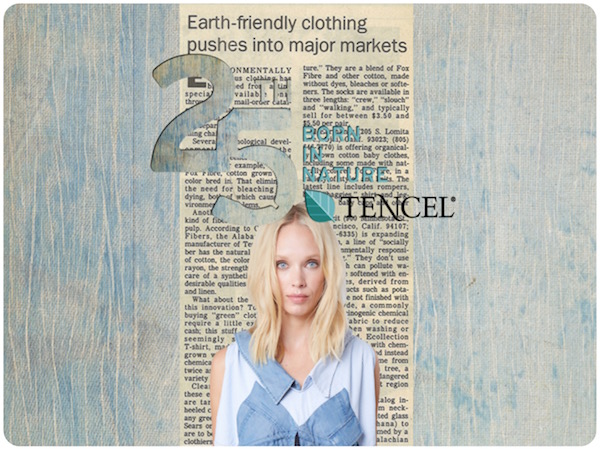
TENCEL® Fibers in the Future
For 25 years, TENCEL® branded lyocell fibers have influenced denim design by expanding its potential in fashion. Now and into the future, with sustainability one of the most critical challenges for the apparel industry, fabrics with TENCEL® fibers have the ability to be highly relevant for many decades to come.
In the early years of TENCEL® fibers, it took creative designers interested in revolutionizing fashion to recognize its potential, and determined makers and mills willing to work out its quirks to help them realize it. A quarter century on, TENCEL® fibers is now an essential fiber for denim makers interested in escalating its performance and feel, from the mass market to the luxury space.
Carved in Blue spoke with some of the designers who discovered fabrics with TENCEL® fibers when it was still new to market. We’ve already written about their first encounters, and now we share their thoughts about the future of TENCEL® fibers
Bottom line: For 25 years, TENCEL® fibers has helped to change denim design, by expanding its potential in fashion, and that progress continues.

Unceasing progress & innovation
It helps that the kinks have been worked out, leaving designers and makers to focus on continued innovation. “It is much easier to work TENCEL® today than 10 years ago because we have the know-how,” says Jose Royo, Sales Director at the century-old Spanish textile mill company Tejidos Royo. “We always put this little bit of TENCEL® to improve the fabric. It is still today a different fiber, an innovative fiber. We are still selling more TENCEL® today than we were 10 years ago. TENCEL® is still changing.”
The mark on the fashion world has been indelible, according to many of the designers and influencers who spoke to Carved in Blue about where TENCEL® fibers go from here. Simply put, there’s no way that fashionistas will ever give up the feel and drape that TENCEL® fabrics deliver.
“I think the indigo fabrication is here to stay forever, because, especially in women’s fashion, where hand-feel and texture is everything,” designer Sigrid Olsen, who discovered the benefits of TENCEL® fibers early on and used it to give a stylish spin to comfortable clothing. “Women want all categories—shirts, dresses, jeans—to feel good.”
The longevity of TENCEL® fibers stems not just from its unique attributes, but also its versatility—its ability to “play well with others” in blends that make fabrics better than the sum of their parts. “I think TENCEL® has become a staple in the denim industry and it’s here to stay,” Raphael Javaheri, now CEO of premium fabric maker ECOTEX, told Carved in Blue. “TENCEL® is very flexible, as it can be used 100% or could be blended with other fibers to give it different and unique characteristics and versatile washing affects. Not to mention, it feels great on.”
New demands, new performance, new world
Indeed, consumers and designers have amped up their expectations of how clothing drapes, moves and reacts in active lifestyles that call for comfort and performance, and TENCEL® fibers has consistently met and exceeded them.
“The future for TENCEL® is something that I spoke to you about last year,” Michael Lew, now designer at Imaginery Concepts Inc., told Carved in Blue. “Finding a technical fiber with thermal regulated control—that when you are hot keeps you cool and when you are COLD it keeps you warm. Mixing a Tri-Blended fiber can achieve this, and make it the next step. Better markets want sustainability, eco-friendly and luxury hand feel, but are now asking to add technology to the mix. Our customers are more mobile now, and active. To have, cotton, polyester, spandex, nylon and TENCEL® would be great fibers to start with in the denim market.”
And, with sustainability now one of the most critical challenges of our time, TENCEL® fibers has a major contribution to make in the future of fashion apparel—and the planet.
“I expect that TENCEL® denim will become more desirable with quality-minded consumers as sustainability becomes more of a factor in the future,” David Rose, now president of Circuit by InRoads motorsports-inspired apparel for men and women. “TENCEL® has become synonymous with quality and luxury fabrics, and the upscale stores and their consumers who have worn the fabric will look for the TENCEL® label in the future and will tell their friends about their experience with these garments.”
With the introduction of TENCEL® fibers, and the recognition 25 years ago by conscientious denim designers, Lenzing has remained in the forefront of sustainable denim alternatives. It was under-appreciated at its debut, but the future demands new fundamentals.
“I think the way in which the fiber was derived and produced was highly underrated 25 years ago by the consumer, which now is a major focus on the impact that apparel has on the environment,” says creative design consultant Jacquie Rumohr, who first worked with TENCEL® fibers when she worked for Ann Taylor Stores in New York as the “ATX” weekend casual designer in the early 1990s. “The future lies in the sustainability and luxury of the fiber and fabric. TENCEL® has come a long way since we all started producing it and enjoying how it feels when worn. Hopefully all the advancements that have been made to use this fiber will propel the fabric into more casual and sustainable collections worldwide!”
Denim—not just cotton any more
While there was a time when cotton was perceived as the only true fiber for denim, TENCEL® fibers may be its savior, too, thanks to the blends that reduce the amounts of cotton needed.
“Going forward it’s going to be incredibly important for us to reduce our dependence on cotton because, as much as we like it, we know that cotton puts a lot of strain on agricultural resources, farming, water consumption,” says design consultant Stefano Aldighieri, who has served as creative director at 7 For All Mankind, Levi’s and Arvind. “If we go back in time, there are very few fibers that have been invented or introduced to the industry and even fewer that have been successful in the denim arena. In the future, one of the challenges we have is to find suitable alternatives to cotton. TENCEL® is one of the fibers we use more often.”
One of the fiercest proponents of that notion is Enrique Silla, CEO of Jeanologia, who believes that TENCEL® fibers and cotton together —and not cotton alone—is the perfect denim combination.
“TENCEL® and cotton is the perfect blend,” he says. “It is giving strength, drape, softness, comfort to the jeans. I do believe that TENCEL® [will] give much more to the jeans industry in the future. TENCEL® should come back to the warp, should be indigo dyed. This will be the revolution.”
In fact, Silla believes that the future is a completely sustainable washed jean. It’s almost here, considering that TENCEL® fibers is already providing the ecologically helpful raw material. “The fiber itself is already sustainable,” he says. “This will make a revolution because sustainability is not a trend anymore— it is a must. It’s something that we need to have.”
That need—the imperative to move away from what has become a wasteful, resource-heavy textile manufacturing sector to one mindful of its impact on the environment—will actually open a new universe for designers and the denim industry, he insists. “TENCEL® is a baby, it is only 25 years old,” he says. “25 for a fiber is like one year for a person. We’re still learning every day.”
The future is here
In some ways, the future is already here, and has been from the beginning. Adriano Goldschmied years ago recognized the importance of TENCEL® branded lyocell fibers to create designs with the environment in mind.
Now Lenzing has once again turned to him to work with a new innovation— Refibra™ branded lyocell fibers. Lenzing commissioned Adriano to design a capsule collection, which showcases fabrics from eight global denim mills and one knit mill with design, production and laundry processing taking place in his Los Angeles studio.
Breakthroughs like Refibra™ fibers positions Lenzing to advance the goals of designers, brands, retailers and consumers who are increasingly interested in low impact options. “My dream is to use less cotton because it uses a lot of land of water and energy— there is no comparison with the production of TENCEL®,” says Adriano, who has incorporated TENCEL® fibers into his designs since 1993 and has remained a steadfast advocate for ecologically minded practices in denim. “Now TENCEL® fibers are evolving to take a new level of sustainability with Refibra™ fibers. We need to open the minds of designers with sustainable innovations.”






